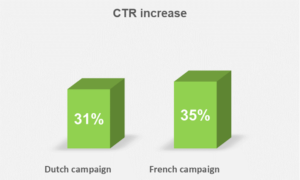

Digital advertising can be very inefficient for one reason: the internet is not a great listener. Despite the many data we (consumers, website visitors) leave behind us, which are constantly analysed and used to target and retarget, digital advertising personalisation reaches a glass ceiling.
Of course, thanks to algorithms and computing power, brands, media agencies, and media publishers know reasonably well who we are, what we like, and what we are currently interested in. Based on context, segments, persona, we are being served with ads supposed to be personalised. And therefore, catching our attention and prompting our interest, if not our action.
But, even with advanced solutions like DCO (dynamic creative optimisation), these personalisation efforts are still missing a key point: how do each individual make decisions?
Indeed, each of us (and therefore each individual visitor to a website) has its own specifics as to how we make decisions. And this is a critical, although under-estimated issue: as ads or communications are missing this point,
we turn a blind eye to them.
That is true for most display ads, but it also prevents branded content to have more impact, and email or subscription campaigns to truly perform as they could. With €180 Billion being spent a year on display advertising, the question of what makes an ad effective has been given quite some attention!
Yet, a Tetra research project done by the Katholic University of Leuven (KUL) and Addrelevance, opens a new horizon for hyper-personalised advertising.
In their paper “Learning to Classify Users in the Buyer Modalities Framework to Improve CTR?”, they prove that this solution, which uses Artificial Intelligence, will bring spectacular benefits to media publishers and brands: significantly increased revenue from digital advertising (display ads, branded content), email or subscription campaigns.
The Buyer Modalities framework is a model that defines four distinct psychological profiles of consumers, according to how they make (purchasing) decisions.
These four types – competitive, spontaneous, methodical, and humanistic – are based on two main criteria: decision speed (impulsive vs. deliberate) and rational (emotional vs. logical). Each profile does react very differently to different types of information: for a same product, or in our example a same ad that is relevant to them, they will pay attention, and take action, or not.
For example, if we consider the purchase of a new car, people with a methodical profile will be more interested in a detailed list of features of the car as can be found in the brochure, whilst the humanistic profile will be more served with testimonials from people who already own the car. Show the wrong value proposition or the wrong call to action to a profile, and they won’t react…
The implication of this model for advertising is that to have an effective campaign, each profile is targeted with an ad tailored toward its information needs. To do this effectively, of course, advertisers, agencies, and publishers need to know the profile of each user. This is not what they have been able to do with existing solutions. This issue has now been solved thanks to the Addrelevance/KUL research.
In their study, the researchers proposed a framework that uses historical user-website interaction data to predict the user profile. It enables the ad server to display the appropriate variant for a particular user in a dynamic way. This approach resulted in a significant increase in the click-through rate (CTR), i.e., the percentage of users viewing a web page who click on an ad displayed on that page. To make sense of the collected data, the whole analysis and prediction has of course to be powered by AI.
This research work involved display advertisings: so-called “banner ads”, banner-like graphical ads often displayed at the top or in the margins of a page. Ever since the advent of online advertising, the click-through rate (CTR) has served as a key measure for the success of an ad campaign.
Their experiment was performed in collaboration with a commercial partner, a media publisher that owns several automotive and real estate magazines and corresponding websites. Since the assumption was that each user can be described by one of the four buyer modalities, the model was trained to predict one of these profiles and does not make a “neutral” prediction.
This study was not allowed to report specific CTR numbers (as per contractual obligations to their commercial partners) but could report changes vs. the baseline. The CTR on banners displayed using this solution was 31% and 35% higher than the baseline CTR for each of the 2 websites (resulting in a minimum of 33% improvement in CTR compared to the reference user group).
Furthermore, by collecting data over several campaigns, the model can also continually be further improved by incrementally retraining the model. On the follow-up campaign, the CTR improved by more than 50%!

CTR increase with digital advertising personalisation solution from Addrelevance, using buying modalities framework and consumers decision-making profiles
A second campaign, for a different car (by the same brand as the first campaign), using this system over a period of four weeks, resulted in a CTR 129% and 94% higher than the baseline determined in the previous campaign.
This Buyer Modalities framework can be used to improve the CTR on online ads, but also traffic and impact on branded content, and owned campaigns (email, subscription, etc.).
In addition, this method does not require a new training phase for each new campaign, as the user modality profiles do not change (even if the ads or the content does change). This implies that, given careful design of the ad variants, once the model has been trained, it should be applicable to any campaign.
This is a solution that would particularly benefit brands advertising high price and high perceived risk products and services (called high involvement products), such as: automotive, banking, insurance, luxury goods, consumer electronics, consumer IT & communication products.
This research has been applied by Addrelevance, with a solution being used to significantly increase the Click Through Rate and the Conversion Rate for ads and communication campaigns: display advertising, branded content, email campaigns, subscription campaigns, etc. This goes beyond personalisation as we know it. It can be used within the standard ad systems and technology, with a fast and simple set-up.
_________________________________________________________
The Addrelevance solution (www.addrelevance.ai) significantly increases the impact of digital advertising, digital content, and online conversion (+30 to 50% click-through rate and conversion rate). Their innovative process is unique: powered by Artificial Intelligence, it goes well beyond current advertising targeting, personalisation, and segmentation solutions, by predicting websites visitors’ decision-making profiles. This is truly digital advertising hyper-personalisation, and conversion rate optimisation pushed to a new level.
#Personalisation #DigitalAdvertising #ClickThroughRate #AI
Addrelevance is supporting advertisers, brands, ad & media agencies, and media publishers: they use the buyers’ profiles provided in real-time by Addrelevance to serve content, value propositions, and call to action that do trigger consumers’ action.
Addrelevance is an AI, data, and adtech startup based in Belgium. They are supported by Microsoft, by imec.istart, and are an IAB approved vendor (GDPR and TCF 2.0 compliant).


